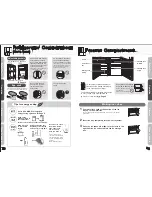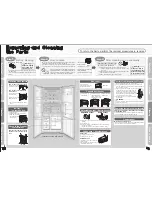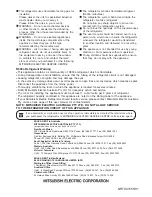
18
19
When in trouble
Before Use
Operation
Cleaning
When in trouble
Before Use
Operation
Cleaning
Problem Check Explanation and action
Door alarm sounds
Is the door of the refrigerator or freezer compartments
open?
Is the rotating partition of the refrigerator compartment
turned up to the front?
Close the door. The alarm sounds at every minute
after the door is opened, and after 4 minutes it sounds
continuously.
If the alarm sounds even after closing the door, press the
ENERGY SAVING button and RAPID COOL button at the same
time for about 3 seconds to stop it. An inspection is required.
Contact the retail store where you purchased the refrigerator or
MITSUBISHI ELECTRIC SERVICE CENTRE.
Check the position of the rotating partition while the
doors are open.
Ice cube is small
or joined together
Has ice been stored inside for a long time?
If the ice is stored for a long time, ice cubes may stick
together or shrink.
(Due to a phenomenon called sublimation.)
Noise interferes
with televisions or
other devices
Is the refrigerator installed near to an electronic device
such as a television?
Is the power to the refrigerator supplied from a socket
near the entry hole of the antenna cable?
Install the refrigerator away from electronic devices such
as televisions.
We recommend using a dedicated power supply.
Loud noises
Annoying noise
These noises
are normal.
The noise gets louder suddenly or the tone changes.
A whistling sound is made after closing a door.
A hissing, bubbling or running water sound is made
sometimes.
A whipping or dripping sound is sometimes heard
from inside the refrigerator after a door is opened.
A buzzing sound is made sometimes.
Immediately after installation, when the weather is hot,
when the doors are frequently opened and closed, during
the rapid cooling operation, and in similar situations, the
refrigerator switches to high-speed operation and cools
with high power.
This is the sound of the fan motor starting.
This is the sound of the refrigerant (gas) flowing.
This is the creaking sound as warm air enters and
expands the plastic.
the air flow.
This is the operating sound of the damper as it adjusts
Pages 9, 16
Page 11
The refrigerator does not cool
at all!
The control panel turns
off automatically!
Strong odours on the
food or ice!
The outer walls heat up!
!""
The refrigerator takes time to cool when you first start using it.
Especially in the summer, it may take up to 24 hours for the inside to
be fully cooled.
!""
Are the displays on the control panel blinking?
Demonstration operation:
Is the power plug disconnected or has the circuit breaker
!
tripped?
To save power, the display goes off
!
if there is no operation for about 30
seconds.
Have you placed food with strong
!
odours inside the refrigerator without
sealing in a container?
The outer walls heat up significantly (to about 50 to 60
o
C)
!
immediately after installation and in the summer. This is
because the heat discharging and condensation prevention
pipes are located on the sides and the top of the refrigerator.
They are required for cooling and the heat is not an abnormality.
The refrigerator compartment rotating partition also has a
!
condensation prevention heater that heats up.
!"
A heat discharging fan is located at the bottom of
the refrigerator. Warm air may be blown from here.
First, check the items described in this section. If the problem persists, contact the retail store where you purchased
the refrigerator as soon as possible.
Frequently asked questions in the initial period and in summer
Questions about operation and handling
Page 8
Page 11
Page 16
Page 6
Problem Check Explanation and action
Does not cool well
Not much ice is
made
Ice melts
Is “Low” set as the temperature for the compartment?
Has enough time passed after installation?
Is heat discharging being blocked? Check there is
gap around the refrigerator and the refrigerator is not
exposed to direct sunlight.
Is the flow of cold air being blocked? Are the doors
being opened frequently, or is a door ajar?
Set the temperature to “Mid” or “High”.
It takes about 4 or 5 hours for the refrigerator to cool,
and up to about 24 hours in the summer to make ice.
Check that the refrigerator is installed correctly.
Check the quantity of food inside and ajar door.
Food freezes in
the refrigerator
compartment
Is the temperature on the control panel set to "High"?
Is food with a lot of moisture stored at the rear of the
shelf?
Is the surrounding temperature 5
o
C or less?
Set the temperature to "Mid". Note that in the rapid cooling
operation, the temperature inside the refrigerator drops temporarily.
Place drinks and food containing a lot of moisture,
such as tofu, vegetables and fruit, at the front.
Freezing is likely to be prevented when the temperature
settings of the refrigerator compartment and vegetable
compartment are set to “Low”.
Cannot adjust the
temperature
Is
displayed?
Cancel the child safety lock.
Condensation
forms on the outer
walls and inside the
refrigerator
Frost forms in the
freezer compartment
Water drips onto the
floor
Are the doors being opened frequently, or is a door
ajar?
Is the humidity high, for example is it raining?
When moisture in the air cools, it forms frost or
condensation. Even when a door is open only slightly,
it can cause frost or condensation, or dripping onto
the floor.
Condensation may form temporarily. Wipe off with a
dry cloth. It is also easy for frost to form in the freezer
compartment. Minimize the time that the doors are open.
Doors open easily
Doors do not close
Is a door making contact with food or a case?
Is too much food packed inside?
Has food fallen behind a case in a drawer door, or is
the power cord or another object trapped between the
refrigerator and a door?
Is the refrigerator installed stably?
Are the adjustable supports making contact with the
floor?
Store food so that the door does not make contact
with objects when closed.
Remove any objects. Make sure that the door does not
trap objects such as food, power cords or plastic bags.
Lower the adjustable supports to raise the front side
slightly and make the doors easier to close.
Page 6
Pages 12
Page 9
Page 12
Page 7
!"#$%&$%'()*+,#
CAUTION
1. This appliance is designed for use in ambient temperature listed below.
The internal temperatures could be affected by such factors as the location of the refrigerating appliance, ambient
temperature and the frequency of door opening, and, if appropriate, a warning that the setting of any temperature
control device might have to be varied to allow for these factors.
2. A rise in temperature of the frozen food during manual defrosting, maintenance or cleaning could shorten the storage life.
3. Food to be frozen is not to be placed in direct contact with food in storage and, if appropriate, that it could be
necessary to reduce the quantity to be frozen if freezing every day is anticipated.
4. The electrical power failure for 1-2 hour will only slightly effect the inside temperature. However, open & close of
the door results in the temperature loss. In case there is more than 24 hours electrical power failure, the food
should be taken out from the fridge.
5. In case you are leaving or there is no food in the fridge for more than 3 weeks, The fridge should be unplugged
and cleaned.
MODEL NAME
AMBIENT TEMPERATURE RANGE
CLIMATIC CLASS
MR-L650EH, L710EH-A
16
o
C ~ 43
o
C
T
MR-L650EH, L710EH-NZ
16
o
C ~ 43
o
C
T
Illustration of the MR-L710EH





























